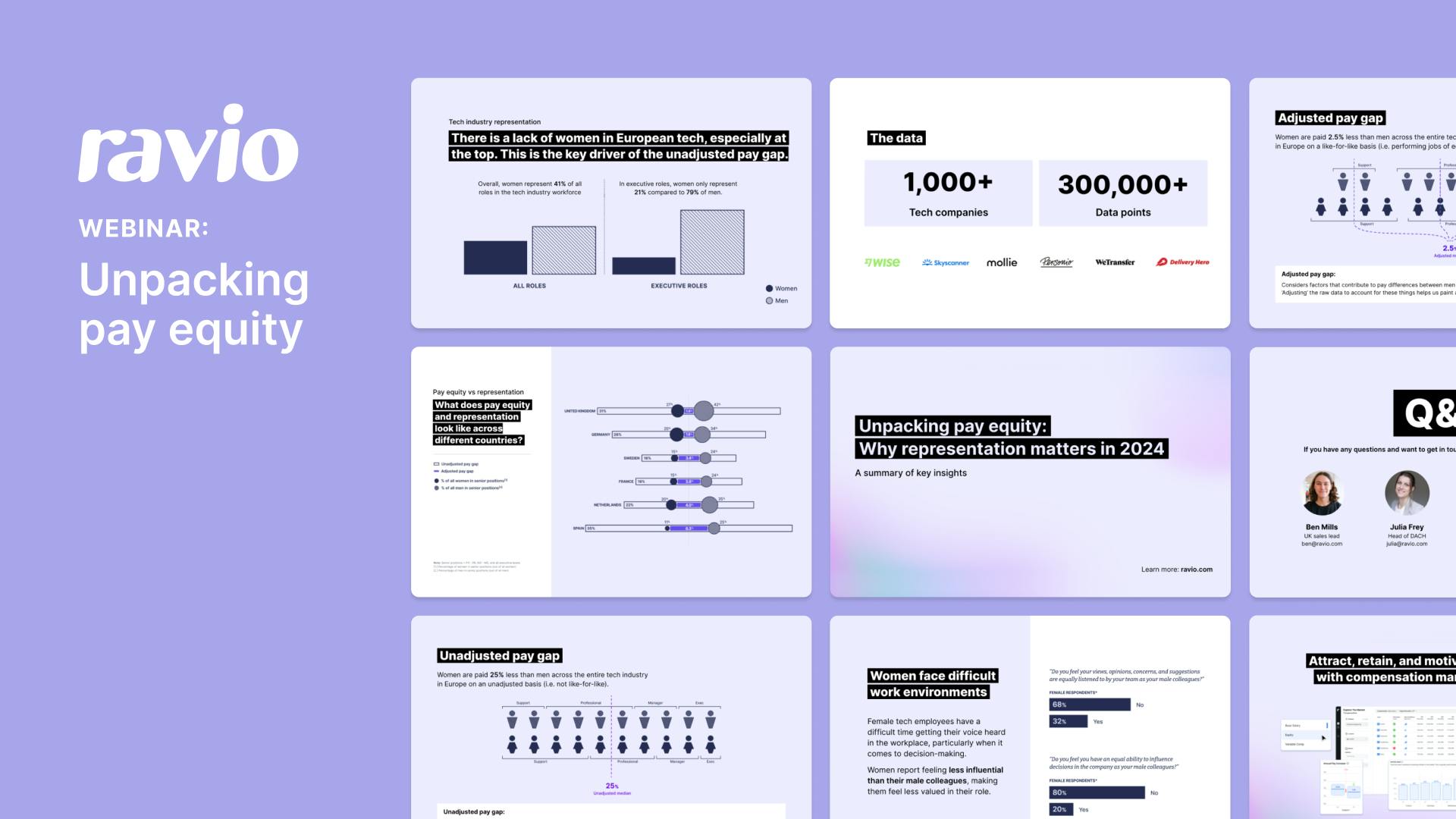One of the biggest focus areas for companies today is improving the gender pay gap. But doing that isn’t a simple task. What does the gender pay gap really look like? What other factors are at play?
In Ravio’s recent webinar, host Merten Wulfert, CEO and Founder at Ravio, unpacks some key insights from our recent pay equity report. He discusses the broader topic of representation and the adjusted and unadjusted gender pay gap with the panel: Vaso Parisinou, Chief People Officer at Ravio and Emma Baker, Chief of People Operations and Reward at Zoopla.
Watch the webinar here to understand:
- The unadjusted and adjusted gender pay gaps, the difference between the two, and why this matters
- The role of representation in pay equity
- How pay equity varies across Europe, and which countries are leading the way
- What factors contribute to the lack of female leaders
Not got time? Here’s some key takeaways from the discussion.
There are different types of gender pay gaps, and a huge representation problem
The gender pay gap is not simply just a gap in wages. There are different ways to look at the gender pay gap, which can usually be broken down into the unadjusted gender pay gap and the adjusted gender pay gap.
When we look at the gender pay gap across the board (median, unadjusted), then women earn 25% less than men. When we look at the gender pay gap as a like-for-like comparison (median, adjusted), then women earn 2.5% less than men for doing equal work of equal value.
Merten Wulfert unpacks what these both mean and what the gender pay gap is for both of them.
"The unadjusted pay gap looks at the median earnings of women compared to median earnings of men… The adjusted pay gap controls for these factors [like job level and country] and provides more of a like-for-like comparison of people who perform jobs of equal value.” - Merten Wulfert
Merten then also discusses the relationship between the unadjusted gender pay gap and representation: that there are less women in European tech overall, and especially in senior positions. This differs when we look at each country across Europe.
There are less women in European tech than men
The panel discusses the biggest, and somewhat hidden problem when it comes to the gender pay gap today: the lack of women in European tech. Representation is the single biggest contributor to the gender pay gap today.
In the webinar, Merten asks panellists Vaso Parisinou and Emma Baker why there are so few women in European tech, especially in senior positions.
Vaso Parisinou discusses a lack of female role models and how this can act as a deterrent for women wanting to enter the tech sector.
Emma Baker from Zoopla (part of Houseful) also discusses the importance of ensuring a fair candidate pipeline, and how as an organisation they have focused on transforming education that young women receive in schools.
“A lack of female role models in tech is what is keeping women out of applying into roles in tech… [It encourages] a societal perception that tech is predominantly a male space. There'll be tons of men who work in that company, which encourages the kind of thinking that women might not belong.”
There are significantly less senior women in European tech than men
The panel also discusses the problem at the top: there are less women in senior positions than men.
Vaso Parisinou runs through three key contributing factors to the lack of female senior leaders in tech:
- Raising a family: Vaso discusses the change women have in their career aspirations since having children and how the tech sector still has a way to improve when it comes to parental leave.
- Perceptions and attitudes: Vaso explores how the vast majority of women feel they still don’t have equal opportunities to men within their organisation.
- Difficult work environment: Vaso’s last point discusses how women still have a difficult time getting their voice heard at work, and how the majority of women feel they are less influential than their male colleagues.
Little buy-in to change
Merten Wulfert asks the panel a question about senior leadership not seeing gender diversity as a priority, and how companies can navigate this challenge to still ensure the gender pay gap continues to close.
“[Senior] men and women look at the data and they acknowledge the fact that they have a very male dominated workforce. But they don't necessarily see it as an issue. If those people happen to be in the critical leadership positions, I imagine it's very hard to bring about any change.”
Zoopla's journey to pay transparency
In the last section of the webinar, Emma Baker, Head of People Operations and Reward at Zoopla dives into some initiatives they have at Zoopla to address pay equity this year.
- Improving the female candidate pipeline and ensuring a fair hiring process
- Providing a varied range of policies to support parental leave, flexibility, remote working
- Training managers to be able to have robust, supportive conversations within the organisation, including a senior leadership development programme
- Improving the promotion process, ensuring a diverse panel. Having managers submitting very clear business cases which have clear criteria linked to career frameworks.
“[We want to} package it all up to ensure that people returning to work, people within the business that have got caring responsibilities, families, women in particular, returning from maternity leave, have got that all rounded support from the business.” - Emma Baker



